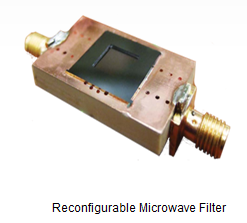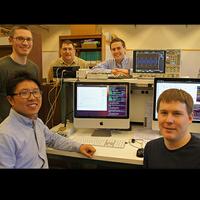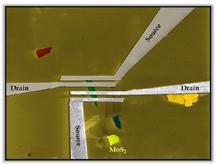 |
Greetings from West Lafayette
As 2013 comes to a close, we continue to celebrate the 125th year of the founding of the School of ECE. It is safe to say that in its long history, ECE has never been stronger.

We are proud of our long and continuing legacy of excellence in education and research. Our talented faculty, at over 80 members, has attracted an unprecedented number of the world's brightest engineering students, including over 500 PhD students, the highest number ever in our history. Their collaboration has resulted in many successful and nationally recognized research projects, funded by over $33 million in annual research dollars. Our investment in academic excellence has contributed to consistent top ten rankings for both our undergraduate and graduate programs.
We feature two examples of our strength in research in this newsletter. A reconfigurable microwave filter, developed by an ECE professor and three of the school's alumni, has recently been awarded a contract for further research towards commercialization by the U.S. Navy. Faculty members are also leading important advances in nanotechnology with a newly developed semiconductor based on two-dimensional nanocrystals.
ECE graduate students are likewise making waves in the engineering community. A research team including three students recently qualified as the top seed for the DARPA Spectrum Challenge, which encourages the development of adaptive radio communications.
I invite you to take a look at the outstanding accomplishments of our students and faculty featured in this newsletter. As always, we welcome your feedback and appreciate your continued interest in Electrical and Computer Engineering at Purdue.
Sincerely,
V. Ragu Balakrishnan
Michael and Katherine Birck Head
Professor of Electrical and Computer Engineering
|
Graduate students play a pivotal role in ECE's 125 years of excellence
In 1888, Purdue's School of Electrical Engineering originated with three faculty members and a handful of students. 125 years later, the school has become an international research powerhouse that always puts students first.
Those first few electrical engineering students would be astonished at the amount of growth that the school has sustained. Purdue's exceptional reputation and transformational learning and research facilities are attracting more students than ever. This year the ECE student population has topped out at 995 undergraduate students. Even more impressively, the graduate student population stands at 750 students, making Purdue's graduate program among the largest in the country.
This milestone in the life of the school is appropriately celebrated by the accomplishments of Purdue ECE's outstanding students. In just the past year, they have earned numerous accolades, including two Best in Session awards at the TECHCON 2013 Conference, a Best Paper Award at ACL 2013, and an IEEE Photonics Society Graduate Student Fellowship among others.
ECE's faculty has the size and expertise to match that of our students. The 85 faculty members include four members of the National Academy of Engineers and thirty-five IEEE fellows, and the school is poised to grow in the coming year. Recently, our research has been showcased by IEEE, Digital Battlespace Magazine, and OSA; and faculty have been featured as keynote speakers at international conferences.
The expansive and innovative research being done by ECE's faculty and students is a testament to the quality of the program. Research expenditures for the last academic year totaled over $33 million, the largest of any department at Purdue. This funding allows the school to invest in collaborative learning and to create an environment that will continue to attract and retain world-class researchers in electrical and computer engineering.
|
U.S. Navy awards Indiana Microelectronics, ECE $500,000 to develop Reconfigurable Microwave Filter
 The U.S. Navy has awarded an 18-month Small Business Technology Transfer (STTR) Phase II contract worth $500,000 to develop the Reconfigurable Microwave Filter, an innovation developed in ECE by Professor Dimitrios Peroulis and commercialized by Indiana Microelectronics LLC, a Purdue Research Park-based firm comprised of three ECE alumni. The U.S. Navy has awarded an 18-month Small Business Technology Transfer (STTR) Phase II contract worth $500,000 to develop the Reconfigurable Microwave Filter, an innovation developed in ECE by Professor Dimitrios Peroulis and commercialized by Indiana Microelectronics LLC, a Purdue Research Park-based firm comprised of three ECE alumni.
The Tunable Bandstop Filters for the Mitigation of Co-site Interference and Jamming Sources contract was awarded June 26.
The contract funds a joint partnership between Indiana Microelectronics and Purdue's Adaptive Radio Electronic and Sensors Team, lead by Peroulis, a professor of electrical and computer engineering.
|
ECE research team qualifies as top seed for DARPA Spectrum Challenge
 An ECE research team consisting of students Sooyoung Hur, Andrew Marcum, and Andrew Balmos and Professors James Krogmeier, David Love, and Xiaojun Lin, has qualified as the top seed for the DARPA Spectrum Challenge. Of the 90 teams originally registered, 46 completed three qualification hurdles and the top 15 have been selected for the Spectrum Challenge Tournament, which will take place over the next year. The ECE team, which also included Raytheon BBN, qualified with the highest score. An ECE research team consisting of students Sooyoung Hur, Andrew Marcum, and Andrew Balmos and Professors James Krogmeier, David Love, and Xiaojun Lin, has qualified as the top seed for the DARPA Spectrum Challenge. Of the 90 teams originally registered, 46 completed three qualification hurdles and the top 15 have been selected for the Spectrum Challenge Tournament, which will take place over the next year. The ECE team, which also included Raytheon BBN, qualified with the highest score.
The DARPA Spectrum Challenge is a competition to demonstrate a radio protocol that can best use a given communication channel in the presence of other dynamic users and interfering signals. The Challenge is not focused on developing new radio hardware, but instead is targeted at finding strategies for guaranteeing successful communication in the presence of other radios that may have conflicting coexistence objectives. The Spectrum Challenge will entail head-to-head competitions between one team's radio protocol and an opponent's in a structured testbed environment. In addition to bragging rights for the winning teams, one team could win as much as $150,000.
|
Layered '2-D nanocrystals' promising new semiconductor
WEST LAFAYETTE, Ind. - Researchers are developing a new type of semiconductor technology for future computers and electronics based on "two-dimensional nanocrystals" layered in sheets less than a nanometer thick that could replace today's transistors.
 The layered structure is made of a material called molybdenum disulfied, which belongs to a new class of semiconductors - metal di-chalogenides - emerging as potential candidates to replace today's technology, complementary metal oxide semiconductors, or CMOS. The layered structure is made of a material called molybdenum disulfied, which belongs to a new class of semiconductors - metal di-chalogenides - emerging as potential candidates to replace today's technology, complementary metal oxide semiconductors, or CMOS.
New technologies will be needed to allow the semiconductor industry to continue advances in computer performance driven by the ability to create ever-smaller transistors. It is becoming increasingly difficult, however, to continue shrinking electronic devices made of conventional silicon-based semiconductors.
"We are going to reach the fundamental limits of silicon-based CMOS technology very soon, and that means novel materials must be found in order to continue scaling," said Saptarshi Das, who has completed a doctoral degree, working with Joerg Appenzeller, a professor of electrical and computer engineering and scientific director of nanoelectronics at Purdue's Birck Nanotechnology Center. "I don't think silicon can be replaced by a single material, but probably different materials will co-exist in a hybrid technology."
|
Electrical and Computer Engineering professor honored with Purdue research award

WEST LAFAYETTE, Ind. - Andrew Weiner, the Scifres Family Distinguished Professor of Electrical and Computer Engineering and a member of the NAE, is the 2013 recipient of the Herbert Newby McCoy Award, the most prestigious research honor in the natural sciences given by Purdue University.
Weiner and his team have shown how to finely control the spectral and temporal properties of ultrafast light pulse, a step toward creating advanced sensors, more powerful communications technologies and more precise laboratory instruments.
The pulses could be likened to strobes used in high-speed photography to freeze fast-moving objects. These laser pulses, however, are millions of times faster, with flashes lasting as little as a quadrillionth of a second - a femtosecond.
The properties of the pulses, when represented on a graph, take on specific shapes that characterize the changing light intensity from the beginning to end of each pulse. Precisely controlling this intensity, which is called "pulse shaping," enables researchers to tune the laser pulses to suit specific applications.
"As a result of Professor Weiner's work, pulse shaping is now used in ultrafast optics, laboratories around the world," said Richard Buckius, Purdue's vice president for research. "His discoveries have influenced research in fields ranging from Quantum control to high-speed light-wave communications."
Weiner's recent work has focused on line-by-line pulse shaping, ultrabroadband radio frequency photonics and microresonator-based signal processing, efforts which continue to push the boundaries of optical science.
|
Purdue University
School of Electrical and Computer Engineering
465 Northwestern Avenue
West Lafayette, Indiana 47907
(765) 494-3540 |
|
|